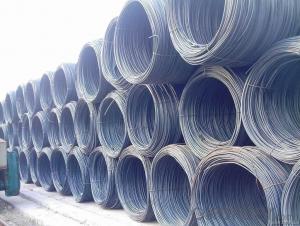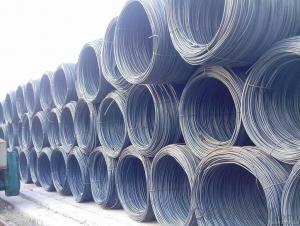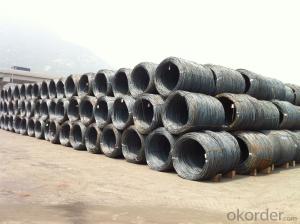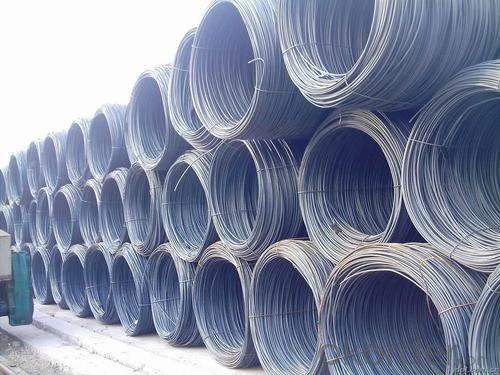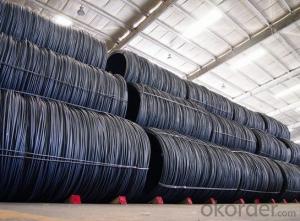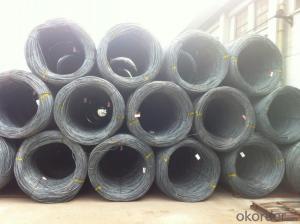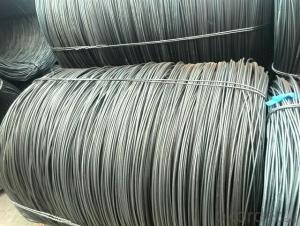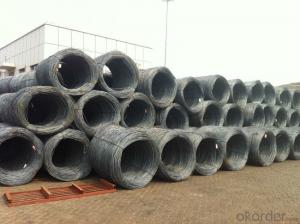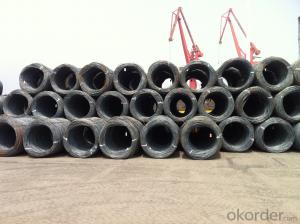Hot rolled Wire Rods With High Quality SAE1008
- Loading Port:
- Tianjin
- Payment Terms:
- TT OR LC
- Min Order Qty:
- 25 m.t
- Supply Capability:
- 10000 m.t/month
OKorder Service Pledge
OKorder Financial Service
You Might Also Like
Specification
OKorder is offering SAE1008 Wire Rods at great prices with worldwide shipping. Our supplier is a world-class manufacturer of steel, with our products utilized the world over. OKorder annually supplies products to European, North American and Asian markets. We provide quotations within 24 hours of receiving an inquiry and guarantee competitive prices.
Product Applications:
SAE1008 Wire Rods are ideal for structural applications and are widely used in the construction of buildings and the manufacturing, industries.
Product Advantages:
OKorder's Wire Rods are durable, strong, and resist corrosion.
Main Product Features:
· Premium quality
· Prompt delivery & seaworthy packing (30 days after receiving deposit)
· Corrosion resistance
· Can be recycled and reused
· Mill test certification
· Professional Service
· Competitive pricing
Product Specifications:
Manufacture: Hot rolled
Grade: SAE1006 – SAE1008
Certificates: ISO, SGS, BV, CIQ
Length: 6m – 12m, as per customer request
Packaging: Export packing, nude packing, bundled
Grade | Chemical Composition (%) | |||||
C | Mn | S | P | Si | B | |
SAE1006B | 0.03~O.07 | 0.32max | 0.045max | 0.040max | 0.30max | 0.0008min |
Mechanical properties | ||||||
Yield strength(N/mm2) | Tensile strength(N/mm2) | Elongation (%) | ||||
250-280 | 350-380 | ≥32 | ||||
Grade | Chemical Composition (%) | |||||
C | Mn | S | P | Si | B | |
SAE1008B | 0.10max | 0.3~0.50 | 0.050max | 0.040 max | 0.15max | 0.0008 min |
Mechanical properties | ||||||
Yield strength(N/mm2) | Tensile strength(N/mm2) | Elongation (%) | ||||
≥195 | 315-430 | ≥30 | ||||
FAQ:
Q1: Why buy Materials & Equipment from OKorder.com?
A1: All products offered by OKorder.com are carefully selected from China's most reliable manufacturing enterprises. Through its ISO certifications, OKorder.com adheres to the highest standards and a commitment to supply chain safety and customer satisfaction.
Q2:What's your payment terms ?
A2: We can accept T/T,LC at sight and time LC.
Q3: Can you offer the third part inspection certificates ?
A3: Yes, we can apply third part inspection before shipping, such as SGS, BV, etc .
Images:
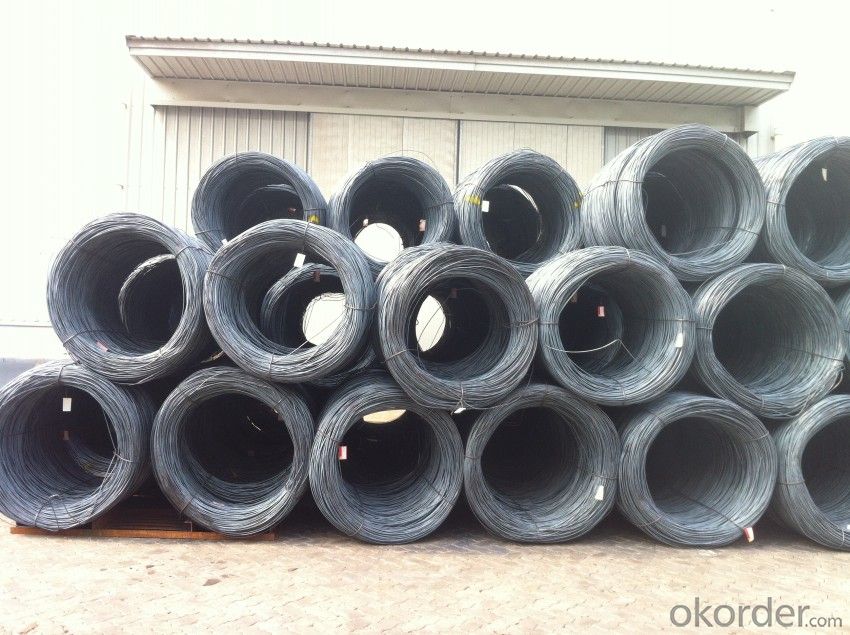
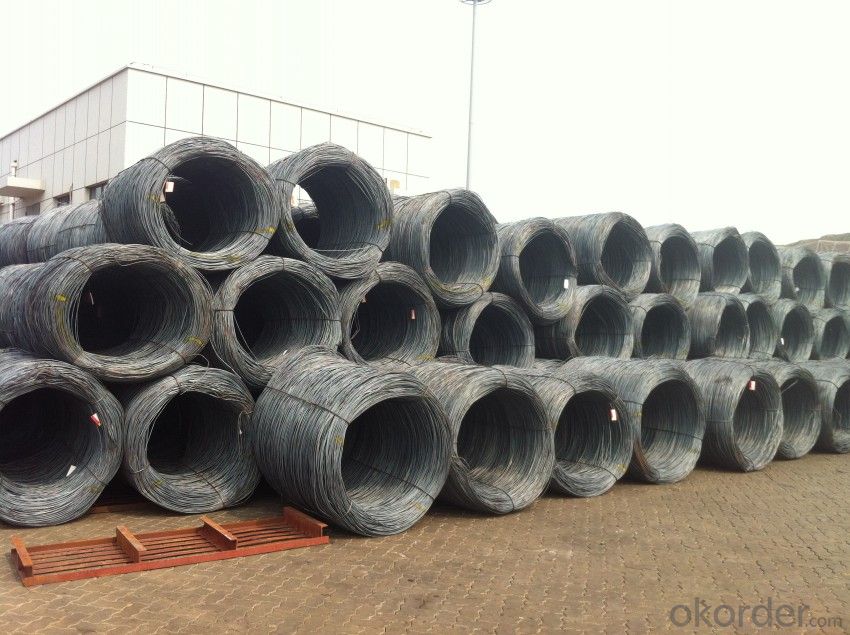
- Q: What are the main factors affecting the market forecasts of steel wire rod?
- The main factors affecting the market forecasts of steel wire rod include global economic conditions, demand from end-use industries such as construction and automotive, raw material prices, government policies and regulations, technological advancements, and competition from alternative materials.
- Q: What are the different types of steel wire rod surface defect detection methods?
- There are several types of steel wire rod surface defect detection methods, including visual inspection, magnetic particle inspection, dye penetrant inspection, eddy current inspection, ultrasonic inspection, and laser scanning inspection. These methods help identify various surface defects such as cracks, pits, scratches, and coating abnormalities, ensuring the quality and integrity of the steel wire rod.
- Q: How is steel wire rod used in the manufacturing of wire for telecommunications cables?
- Steel wire rod is an essential component in the manufacturing of wire for telecommunications cables. The process begins with the production of steel wire rod, which is a long, cylindrical billet made of steel. This wire rod is then processed and transformed into a wire that is suitable for telecommunications cables. To manufacture wire for telecommunications cables, the steel wire rod undergoes several steps. Firstly, it is cleaned and descaled to remove any impurities that may affect the quality of the wire. The wire rod is then heated and passed through a series of rollers to reduce its diameter and increase its length. This step is known as wire drawing and is crucial in achieving the desired thickness and strength of the wire. Once the wire has been drawn to the required size, it is further processed to ensure its quality and reliability. The wire is annealed, a process in which it is heated and slowly cooled to relieve internal stresses and enhance its flexibility. This makes the wire more suitable for handling and installation in telecommunications cables. After annealing, the wire is coated with a layer of insulation material, such as polyethylene or polyvinyl chloride (PVC). This insulation provides electrical insulation and protects the wire from external factors that may damage its conductivity, such as moisture or extreme temperatures. The final step in the manufacturing process is to twist multiple wires together to form a cable. Steel wire rod is used as the core strength member within the cable, providing structural support and tensile strength. This ensures that the cable can withstand the tension and bending forces it may encounter during installation and operation. In summary, steel wire rod is a crucial component in the manufacturing of wire for telecommunications cables. It undergoes a series of processes, including cleaning, wire drawing, annealing, and insulation, to create a wire that is suitable for use in telecommunications applications. The strength and reliability of steel wire rod make it an ideal choice for providing the necessary structural support and durability required in telecommunications cables.
- Q: How is steel wire rod used in the manufacturing of wire for electrical circuitry?
- Steel wire rod plays a vital role in the wire manufacturing process for electrical circuitry. It serves as the initial material that undergoes various treatments and processes to eventually become the wire used in electrical circuits. To utilize steel wire rod, it must first go through a series of mechanical and chemical treatments. These treatments, including heating, cooling, and drawing, aim to enhance its strength, flexibility, and conductivity. By subjecting the rod to these processes, it ensures that the resulting wire can withstand electrical current without breaking or losing its shape. Once the steel wire rod has undergone proper treatment, it is then shaped according to the desired form. This may involve further drawing, twisting, or braiding to achieve the necessary dimensions and characteristics needed for electrical circuitry. The wire is often sized to specific diameters and coated with insulating materials, such as enamel or plastic, to prevent short circuits and protect it from external influences. The manufactured wire is then used in various applications within electrical circuitry. It can be employed in the production of electrical cables, serving as the conductor that carries electrical current from one point to another. Additionally, the wire is utilized in the construction of transformers, motors, generators, and other electrical equipment. The utilization of steel wire rod in wire manufacturing for electrical circuitry is crucial due to its excellent conductivity, strength, and durability. It ensures the safe and efficient transmission of electricity, while also withstanding the mechanical stress and environmental conditions it may encounter during use.
- Q: What are the standard ductility requirements for steel wire rod?
- The standard ductility requirements for steel wire rod are typically defined by specific industry standards and specifications. These requirements may vary depending on the intended application of the wire rod. In general, ductility refers to the ability of a material to deform under tensile stress without fracturing. For steel wire rod, a certain level of ductility is essential as it allows the wire to be easily formed, bent, or stretched without breaking. The specific ductility requirements for steel wire rod are typically expressed in terms of the elongation percentage, which is determined by conducting tension tests on the material. Elongation percentage is calculated by measuring the increase in length of the wire rod after it breaks during the tension test. Common industry standards, such as those set by the American Society for Testing and Materials (ASTM), typically specify minimum elongation requirements for different grades of steel wire rod. These requirements may vary depending on factors such as the wire rod diameter, manufacturing process, and intended application. For example, ASTM A510/A510M-18a, which covers general requirements for carbon and alloy steel wire rods and coarse round wire, specifies minimum elongation values ranging from 10% to 30% depending on the wire rod diameter. Other standards, such as those set by the International Organization for Standardization (ISO) or national standards bodies, may have similar or slightly different requirements. It is important to note that specific applications may have additional requirements beyond standard ductility specifications. For instance, certain industries may require enhanced ductility to meet specific performance criteria or to ensure the wire rod can withstand severe deformation without rupturing. Overall, the standard ductility requirements for steel wire rod are determined by industry standards and specifications, which typically define minimum elongation values. These requirements ensure that the wire rod possesses the necessary deformability to meet its intended application and manufacturing processes.
- Q: How is steel wire rod used in the manufacturing of wire forms for agricultural fencing?
- Steel wire rod is used in the manufacturing of wire forms for agricultural fencing by being transformed into various wire shapes and gauges. It can be straightened, cut, and then either woven or welded into the desired fence forms. The high tensile strength of steel wire rod provides durability and resistance, making it suitable for withstanding the pressure and impact that agricultural fencing may encounter.
- Q: What are the common machining methods for steel wire rod?
- The common machining methods for steel wire rod include cutting, bending, drawing, and threading.
- Q: How is steel wire rod used in the production of tire cords?
- Steel wire rod is an essential component in the production of tire cords. Tire cords are reinforcements that are embedded within the rubber of tires to provide strength and support. Steel wire rod is first processed through a series of steps to transform it into the desired form for tire cord production. The steel wire rod is initially hot rolled to reduce its diameter and increase its length. This process adds strength and flexibility to the wire rod, making it suitable for tire cord applications. After hot rolling, the wire rod is further processed through a heat treatment known as patenting. This heat treatment enhances the wire's mechanical properties, such as tensile strength and elasticity, ensuring it can withstand the demanding conditions experienced by tires. Once the steel wire rod has been appropriately processed, it is then drawn through a series of dies to achieve the desired diameter and surface finish. This drawing process further enhances the wire's strength and surface quality, ensuring it meets the stringent requirements for tire cord production. The drawn steel wire rod is then coated with a layer of brass or zinc to improve its adhesion to the rubber compound used in tire manufacturing. This coating also provides corrosion resistance, extending the lifespan of the tire cords. Finally, the coated steel wire rod is twisted into cord structures with multiple strands, forming the tire cord. These cords are then embedded into the rubber during the tire manufacturing process. The tire cords provide essential reinforcement, helping the tire withstand the internal pressure, external forces, and provide stability during vehicle movement. In summary, steel wire rod is a crucial material used in the production of tire cords. Through a series of processing steps, including hot rolling, heat treatment, drawing, and coating, the wire rod is transformed into high-strength and durable cords. These cords are then embedded within the rubber of tires to provide essential reinforcement and support, ensuring the tires can withstand the challenging conditions they encounter on the road.
- Q: What are the common packaging materials used for steel wire rod coils?
- The common packaging materials used for steel wire rod coils include wooden pallets, steel strapping, plastic wrapping, and metal sheets. Wooden pallets are often used as a base to stack and store the coils, providing stability and easy handling during transportation. Steel strapping is used to secure the coils tightly together, preventing any movement or damage during transit. Plastic wrapping is commonly used to provide additional protection against moisture and dust, ensuring the coils remain in optimal condition. Metal sheets are sometimes placed on top of the coils to provide extra protection and prevent any external damage. These packaging materials are essential for ensuring the safe and efficient handling, storage, and transportation of steel wire rod coils.
- Q: What is the composition of a steel wire rod?
- A steel wire rod is primarily composed of iron, with additional elements such as carbon, manganese, silicon, and sometimes small amounts of other elements to improve its strength and other properties.
Send your message to us
Hot rolled Wire Rods With High Quality SAE1008
- Loading Port:
- Tianjin
- Payment Terms:
- TT OR LC
- Min Order Qty:
- 25 m.t
- Supply Capability:
- 10000 m.t/month
OKorder Service Pledge
OKorder Financial Service
Similar products
Hot products
Hot Searches
Related keywords
